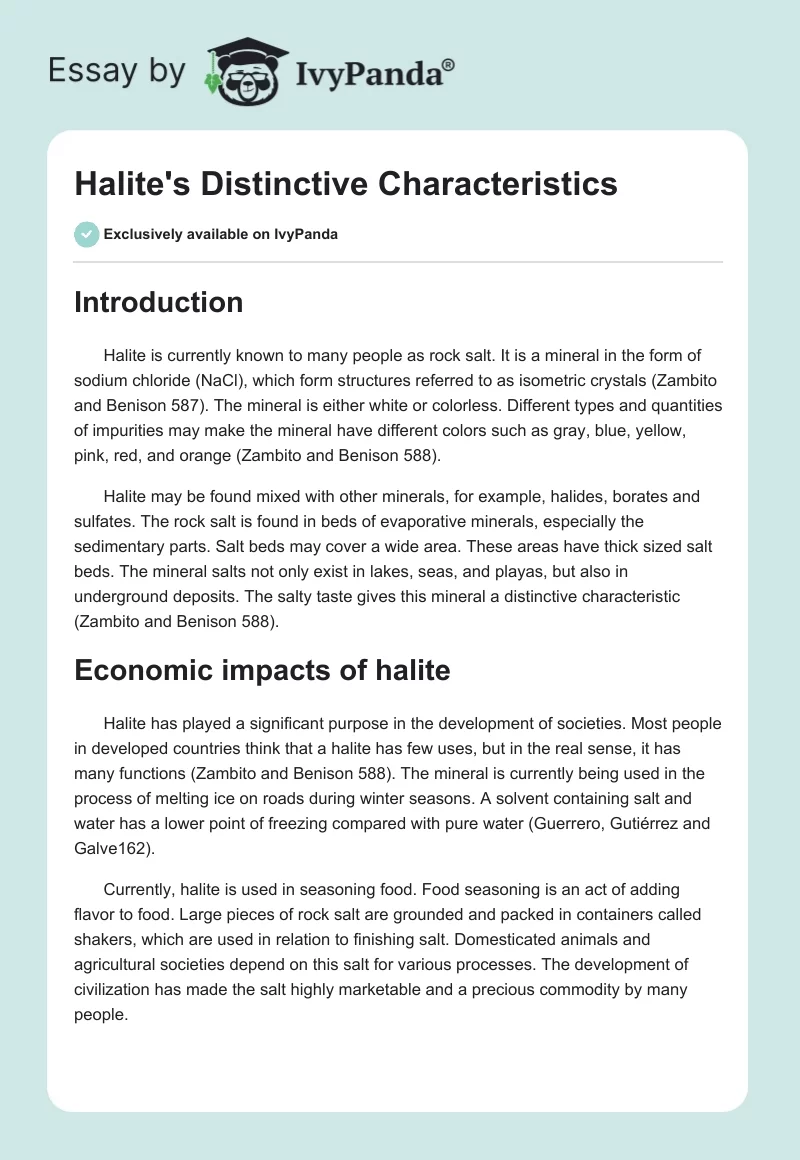Introduction
Halite is currently known to many people as rock salt. It is a mineral in the form of sodium chloride (NaCl), which form structures referred to as isometric crystals (Zambito and Benison 587). The mineral is either white or colorless. Different types and quantities of impurities may make the mineral have different colors such as gray, blue, yellow, pink, red, and orange (Zambito and Benison 588).
Halite may be found mixed with other minerals, for example, halides, borates and sulfates. The rock salt is found in beds of evaporative minerals, especially the sedimentary parts. Salt beds may cover a wide area. These areas have thick sized salt beds. The mineral salts not only exist in lakes, seas, and playas, but also in underground deposits. The salty taste gives this mineral a distinctive characteristic (Zambito and Benison 588).
Economic impacts of halite
Halite has played a significant purpose in the development of societies. Most people in developed countries think that a halite has few uses, but in the real sense, it has many functions (Zambito and Benison 588). The mineral is currently being used in the process of melting ice on roads during winter seasons. A solvent containing salt and water has a lower point of freezing compared with pure water (Guerrero, Gutiérrez and Galve162).
Currently, halite is used in seasoning food. Food seasoning is an act of adding flavor to food. Large pieces of rock salt are grounded and packed in containers called shakers, which are used in relation to finishing salt. Domesticated animals and agricultural societies depend on this salt for various processes. The development of civilization has made the salt highly marketable and a precious commodity by many people.
Mining history
Mineral salts in lakes and seas are easily collected since they are deposited on shores of water bodies after evaporation. The rock salt is also collected from diverted water and tributaries that dry-up leaving behind the salt (Zambito and Benison 588). There are regions that contain underground deposits of halite. This is common with non-arid regions (Zambito and Benison 588). The underground deposits are mined by drilling. Drilling of halite occurs in Texas, where wells are drilled to reach the underground deposit of mineral salt.
The wells are then supplied with hot water to dissolve the mineral (Zambito and Benison 588). A mixture of hot water and the mineral is called brine. The mixture is pumped out and the solution in it will quickly evaporate, leaving behind crystals of salt, which are later harvested. There are parts of Texas where underground salt is pumped to the surface by underground forces. The pumped salt form structures are called salt domes. Formation of salt domes is a unique geological event (Zambito and Benison 588).
Unique features of halite
The taste of a substance can be used to distinguish it from other substances. The salty taste gives halite a distinctive characteristic. The mineral salt can be found as underground deposits or dissolved in water bodies such as the lakes and oceans (Guerrero et al. 163). Halite would have a different color if there are defects, bacteria, and impurities in its structure. For example, pink color is as a result of bacteria and violet color is due to the occurrence of impurities (Guerrero et al. 163). Many people do not know that halite is in food they eat. The salt that people come across every day is an artificial form of halite.
Works Cited
Guerrero, Jesus, Francisco Gutiérrez, and Jorge Galve. “Large depressions, thickened terraces, and gravitational deformation in the Ebro River valley (Zaragoza area, NE Spain): Evidence of glauberite and halite interstratal karstification.” Geomorphology 196 (2013): 162-176. Print.
Zambito, James, and Kathleen Benison. “Extremely high temperatures and paleoclimate trends recorded in Permian ephemeral lake halite.” Geology 41.5 (2013): 587- 590. Print.


